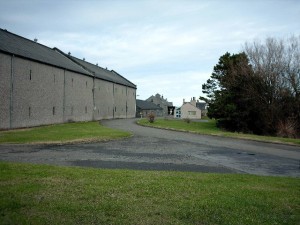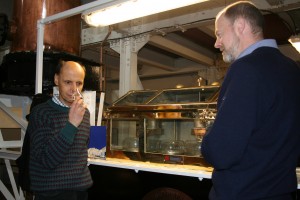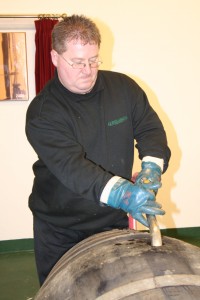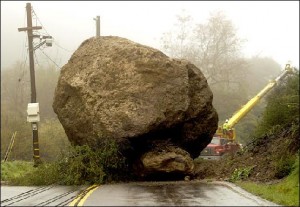 And now for the third installation to my interview series. As you may or may not know, I’ve decided to start this series of interviews to help demystify some of the many aspects of the whisk(e)y industry. Who makes it, how they do it, how they got into it, how to they sell, promote it, market it, etc… While this series is called “A Day in the Life”, it will focus on more than a day in the life of a Cooper, Sales Person, Ambassador, Master Blender, Independent reviewer/critic, etc… Also, I will try to get a little personal (without making said person blush).
And now for the third installation to my interview series. As you may or may not know, I’ve decided to start this series of interviews to help demystify some of the many aspects of the whisk(e)y industry. Who makes it, how they do it, how they got into it, how to they sell, promote it, market it, etc… While this series is called “A Day in the Life”, it will focus on more than a day in the life of a Cooper, Sales Person, Ambassador, Master Blender, Independent reviewer/critic, etc… Also, I will try to get a little personal (without making said person blush).
My third interviewee is Stuart Nickerson, Managing Director of the newly re-opened (2008) Glenglassaugh distillery.
 Stuart, thank you SO MUCH for agreeing to be interviewed, for your great answers and the depth with which you went into!
Stuart, thank you SO MUCH for agreeing to be interviewed, for your great answers and the depth with which you went into!
Stuart has provided me (and you) with so much information here, I thought it’d be best to break the interview into two part. Stay tuned for part two to be posted a week from today. Mark your calendars for Thursday, July 15th, 2010 – part deux to my interview with Stuart Nickerson. Until then, let part one of this great interview begin:
Joshua: Stuart, Glenglassaugh is a newly re-opened distillery (thankfully!). Can you explain the history and reasons for it’s initial mothballing and the impetus for the re-opening? Additionally, how did you become involved in the process?
Stuart: The distillery dates back to 1875 and was founded by James Moir who was a local philanthropist, he was also involved in bringing the telegraph and the train to the town and donated sums of money to local causes as well as gifting the town hall. After his death and the death of one of his two nephews who had helped to start the distillery, it was sold by the remaining nephew in 1892 to Robertson & Baxter who immediately sold it to Highland Distilleries for £15,000 (an increase of £5,000 over the purchase price)
Highland owned it ever since until 2008. They closed it in 1907 and it remained silent until 1959 when a new distillery was built on the site, making use of only one of the original malting buildings (for malt storage) and one of the original warehouses as well as a couple of the cottages for workers.
Following the re-build in 1959 it was opened in 1960 primarily to make a blending malt for the growing blends which were owned or managed by Highland, these include Cutty Sark, Lang’s Supreme and The Famous Grouse. However Glenglassaugh is complex Highland Whisky made from hard water with distinctive fruity aroma and taste rather than a light floral Speyside which is what Highland were looking for and which was already being produced at Glenrothes and Tamdhu. Highland tried in a number of ways to change the spirit, they increased the size of the spirit still, tried using water taken from Glenrothes and finally installed a water softner. None of this worked and so they closed the distillery in 1986 and instead they expanded Glenrothes. From their position this the best position for their business plan.
At the same time I was employed as Distillery Manager of Highland Park Distillery which was also owned by Highland. All the distillery managers were aware of the high quality of Glenglassaugh and enjoyed a dram of it. In 1987 I was asked to become Glenrothes Distillery Manager and at the same time Manger of the Glenglassaugh site which has a fairly large warehouse.
 Fast forward to 2004 when I was keen to set-up my own business and left Wm Grant & Sons after 14 years, the last 9 of these as Distilleries Director. In 2006 I was asked by a group of investors to carry out due diligence on 2 malt distilleries which were operating and up for sale. For various reasons neither of these sales were concluded and I was then asked to find a distillery which they could buy and I had 3 criteria (1) It had to have heritage and so could not be a new-build (2) It had to be produce high quality whisky, and (3) it should have stocks.
Fast forward to 2004 when I was keen to set-up my own business and left Wm Grant & Sons after 14 years, the last 9 of these as Distilleries Director. In 2006 I was asked by a group of investors to carry out due diligence on 2 malt distilleries which were operating and up for sale. For various reasons neither of these sales were concluded and I was then asked to find a distillery which they could buy and I had 3 criteria (1) It had to have heritage and so could not be a new-build (2) It had to be produce high quality whisky, and (3) it should have stocks.
I looked at what was available and several distilleries were considered and rejected for a number of reasons before I approached Edrington (who now owned Highland) and enquired about the availability of Glenglassaugh. They agreed in principle to the sale and there then followed a period of due diligence and creating the business plan before everything was accepted and we eventually took ownership on 29th February 2008.
During this period of time the shareholders asked that I stay on and run the business for them. Well it meant given up running my own business but the opportunity to continue what I had only just started, and also moving back to the North-East of Scotland, was too good an opportunity to miss and so I accepted.
Joshua: With the recent addition of Ronnie Routledge, it’s apparent that you are creating quite the strong team to take the distillery to new heights. Can you give a brief list of who’s on the Glenglassaugh team, what they do and why they were chosen to come aboard?
Stuart: I have always worked with the philosophy that you employ people that are better than you within their field of operation, people that you can work with and people with the attitude and behaviors that fit the business, and for Glenglassaugh that means people that like a challenge, prepared to work outside their comfort zones and understand what it is to make a quality product and deliver all products and services to the best of our ability and to the highest standards.
 Distillery Manager is Graham Eunson who started his career at Scapa Distillery, worked for a while at Glendronach and then moved to Glenmorangie where he was manager for 12 years. (Graham and Stuart shown to the right nosing first run spirit on Dec 4th, 2008)
Distillery Manager is Graham Eunson who started his career at Scapa Distillery, worked for a while at Glendronach and then moved to Glenmorangie where he was manager for 12 years. (Graham and Stuart shown to the right nosing first run spirit on Dec 4th, 2008)
Ronnie Routledge is Customer Account Manager and joins us from Single Malts Direct/Duncan Taylor where he was retail manager, before that he was retail manager with Gordon & Macphail.
Peter Innes is our Bottling and Logistics Leader and previously worked with Duncan Taylor and Gordon & Macphail in similar positions.

Graeme Morrison is in charge of our warehouses and is ex-Chivas were he ran their Keith filling and warehouses operations. (Graeme Morrison shown to the left filling the first cask on December 16th, 2008)
Alan Willetts is our stillman and is ex-Glenmorangie.
Our other team members Ronnie Laurence, Neil McGarvie and Michelle Slater live locally and are new to the industry. Ronne and Neil are skilled tradesmen who can turn their hand to many things while Michelle shares her time between administration and bottling. We really are a multi-task team who do anything and everything!
Joshua: Currently, with the exception of your younger-than-3-years-old spirit drinks, the only expressions Glenglassaugh offers is a 21yr, 30yr and 40yr bottling. As I understand it, these whiskies are not only old but they are rare which makes them a bit on the expensive side. For those not familiar with Glenglassaugh, what can people expect from your whiskies? Do you have a trademark flavor or flavors to your whiskies? In essence, what makes Glenglassaugh stand out from a nose/palate/finish standpoint?
Stuart: Our new make spirit is very fruity, likened to “Eau de vie Poir” and these fresh fruits aromas and tastes can come through in the final whiskies but also develop into a medley of boiled fruits and spices with hints of liquorice and dark chocolate. They age extremely well in refilled casks which allow the flavours the time required to develop and marry.
You can find an extensive tasting of Glenglassaugh whiskies including many independent bottling which was carried out in Norway, here: http://www.whiskychamber.com/a-%c2%absmall%c2%bb-glenglassaugh-vertical/
 Joshua: In 2009, Glenglassaugh won 3 medals — two “Quality Awards” (for your 40yr & Cask Strength expressions) and one Gold Medal/Best in Class award. At just a year into the re-opening of Glenglassaugh, how did this make you feel? Additionally, how did you go about creating these award winning expressions?
Joshua: In 2009, Glenglassaugh won 3 medals — two “Quality Awards” (for your 40yr & Cask Strength expressions) and one Gold Medal/Best in Class award. At just a year into the re-opening of Glenglassaugh, how did this make you feel? Additionally, how did you go about creating these award winning expressions?
Stuart: As you say we won Gold Medal (best in class) and the trophy for Best Cask Strength Scotch at the International Wine and Spirits Competition for our 30 year old and we also won Gold Medal (best in class) and the trophy for Best 40 year old Scotch Whisky at the same competition. We were also awarded 96 points in Jim Murray’s Whisky Bible 2010 for our 40 year old and 94 points for our 21 year old and then recently at the San Francisco World Spirits Competition we won a double gold medal for our 21 year old.
These awards have absolutely delighted myself and the rest of the team, it justifies the shareholders decision to buy the distillery and our faith in what we are doing here.
In many ways we are in an enviable position having a stock which consists of mainly excellent whiskies and a number of these are simply outstanding. However we would like even more of them!
We create the single cask whiskies by a rigorous nosing and tasting system which involves everyone in the company in the initial selection process with the final decision coming down to a core of 3 of us. However it doesn’t stop there because we need to know that after the cask has been emptied that the nose and taste are still the same and more importantly we need to check again after bottling and before releasing for sales.
We are fortunate in that I do not believe in chill-filtration or colouring and I believe that all single malts should be bottled at cask-strength so therefore there is less risk of the whisky changing between sampling in the cask and the final bottled sample.
 Joshua: When you and I spoke on the phone, you had mentioned that you are currently working on establishing US distributions. What are the trials and tribulations? Also, is this for your current offering or for new whiskies as well? (Dear reader, just think, the kids in the picture to the left will be old enough to enjoy Glenglassaugh when they release their 18yr expression!)
Joshua: When you and I spoke on the phone, you had mentioned that you are currently working on establishing US distributions. What are the trials and tribulations? Also, is this for your current offering or for new whiskies as well? (Dear reader, just think, the kids in the picture to the left will be old enough to enjoy Glenglassaugh when they release their 18yr expression!)
Stuart: We have an importer appointed, Purple Valley Imports Inc., but have still to ship any spirit. The biggest frustration is getting our labels approved and then working through the three tier system that is used in the USA and the different ways that it is operated in different states.
Purple Valley will be distributing all of our products which now start with a 26 year old, then “Aged over 30 years” and “Aged over 40 years”. We also have a 200ml triple pack of the three older whiskies (26 year old, 37 year old and 43 year old)
The Spirit Drinks, which are not yet 3 years old, will also be available in 200ml bottles and at 50% abv, these are “Clearac” which is new spirit before it is filled, “Peated” which is also new spirit but it has been produced with peated malt, then there is “Blushes” which is the result of 6 months in Californian red wine barrels and finally “Fledgling XB” which is the result of 12 months maturation in ex-Bourbon barrels.
Joshua: On that same phone conversation you had told me that you basically have the freedom to create what you’d like for the future of the distillery. This being said, what can we, as consumers, expect for the future of Glenglassaugh and what’s the time frame?
Stuart: Firstly we have been experimenting with different cask types as we are looking to find what casks work best with Glenglassaugh and how the spirit/whisky differs from each type and so over the next 18 months there will be further releases of our Spirit Drinks where the spirit had been maturing for longer and from different cask types.
We will release a 3 year old in 2012 although we have not yet decided from which type of cask(s) this will be. There will probably be further aged releases in future years until the whisky becomes at least 10 year old and eventually our main age will become either a 10 or 12 year old.
In general we are very pleased with all of the maturing new spirit and I am convinced that our policy of buying top quality casks from USA and Europe will be beneficial for the consumer and so ourselves as the whisky is bottled and sold.

Joshua: From the standpoint of the managing director of the Glenglassaugh distillery, what would you say your biggest obstacles are in progressing the sales and awareness of your current and future whiskies?
Stuart: There are really quite a few challenges and they will remain for quite some time although obviously we are working on them all. The first one is the fact that the distillery was shut for 22 years which gives us two headaches, firstly the distillery is relatively unknown because we were shut for so long and so there is an exercise just to raise awareness. Related to this is the fact that Highland never pushed Glenglassaugh and so never developed the brand name, there were a small number of individual releases and a number of independent bottling which meant that we did start with number of people in Europe who were aware of Glenglassaugh and realised the quality of it.
The second issue from the shutdown is the lack of inventory which is younger than 24 years and older than 18 months! This means that our aged whiskies are rare, but thankfully of the highest quality which means that once people have tasted them then we find it easier to sell.
Probably the biggest issues are the same ones which face many small companies, lack of human resources and lack of cash flow. We have plenty of ideas and some fantastic potential projects but with only a small team it means that we can’t do everything that we want to do within the time scale that we would want.
Joshua: Recently, there’s been a lot of buzz around new make spirit, white dog, moonshine… call it what you will. Without going into the arguments for or against it, what are your reasons for making your “Spirit Drink That Dare Not Speak It’s Name” new make spirit available for mass consumption?
Part 2 to this interview can be found here.
